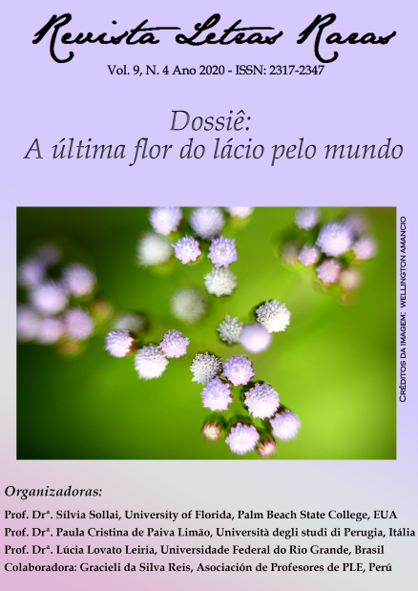O Processamento Lexical de línguas tipologicamente próximas entre falantes trilíngues de Espanhol, Inglês e Português
Palavras-chave:
Processamento lexical, Falantes trilíngues, Falantes de herança, Português, EspanholResumo
DOI: https://dx.doi.org/10.35572/rlr.v9i4.1942
Pesquisas mostram (VAN HESTE, 1999; VAN HELL; DE GROOT, 1998; VAN HEUVEN, DIJSTRA; GRAINGER, 1998) que, quando falantes bilíngues visualizam palavras em diferentes línguas, diferentes níveis de semelhança lexical fazem com que outros vocábulos sejam simultaneamente ativados. Grande parte das pesquisas em processamento lexical se concentra na população bilíngue; enquanto que poucos estudos analisam tal fenômeno entre falantes trilíngues. O presente estudo se propõe a investigar como falantes trilíngues classificados como falantes nativos e de herança em espanhol processam palavras em diferentes idiomas (espanhol, português, alemão e basco) em comparação com falantes trilíngues não-nativos de espanhol. O objetivo é verificar se o terceiro idioma (português) afeta o processamento lexical em um idioma aprendido anteriormente (espanhol). Dois grupos participaram do estudo. O primeiro grupo era composto por falantes nativos de inglês (L1), com segunda língua espanhol (L2), e terceira língua português (L3). O segundo grupo era composto por falantes trilíngues nativos e/ou de herança em espanhol (n = 26) (L1-espanhol, L2-inglês e L3-português). Todos os participantes se encontravam em estágios iniciais de aprendizagem de língua portuguesa (L3). Resultados com base em tempos de reação e precisão demonstraram que falantes trilíngues nativos/de herança processaram palavras em espanhol mais rapidamente que falantes trilingues não nativos, além de processar todos os tipos de palavras (em português, espanhol, alemão e basco) com mais precisão. Os presentes resultados se basearam no modelo Bilingual Interactive Activation Plus (BIA +) de Dijkstra e Van Heuven (2002).
Downloads
Referências
CASAPONSA A, CARREIRAS M, DUÑABEITIA, J. A. How do bilinguals identify the language of the words they read? Brain Research, vol 1624, p. 153–166, 22 Oct 2015.
DE GROOT, A.M.B. Language and Cognition in Bilinguals and Multilinguals: An Introduction. New York: Taylor and Francis, 2011.
DIJKSTRA, A., & VAN HEUVEN, W. J. B. The architecture of the bilingual word recognition system: From identification to decision. Bilingualism: Language and Cognition, vol 5, p.175–197, 18 Dec 2002.
FORCELINI, J & SUNDERMAN. G. When More is Less: The Effect of a Third Language on a Second Language. Hispania, Benjamin Fraser, The University of Arizona, 2021. Forthcoming.
LEMHÖFER, K., DIJKSTRA, A., & MICHEL, M. Three languages, one ECHO: Cognate effects in trilingual word recognition. Language and Cognitive Processes, vol 19, p. 585-611, 2004.
MONTRUL, S. Dominant language transfer in Spanish L2 learners and heritage speakers. Special issue of Second Language Research, vol 26, p. 293-327, 9 Jul 2010.
MONTRUL, S. Subject and object expression in Spanish heritage speakers: a case of morphosyntactic expression, Bilingualism: Language and Cognition, vol 7, no 2, p.125-142, 23 Jul 2004.
VAN HELL & DE GROOT . Conceptual representation in bilingual memory: Effects of concreteness and cognate status in word association. Bilingualism: Language and Cognition. vol. 1, no. 3, p. 193–211, Dec 1998.
VAN HESTE, T. Visual word recognition in bilinguals. 1999, thesis (Masters in Linguistics and Literature) University of Leuven, Belgium
VAN HEUVEN, W. J. B., & Dijkstra, T. The architecture of the bilingual word recognition system: From identification to decision. Bilingualism: Language and Cognition, vol. 5, no 3, p.175-197, Dec 2002.
VAN HEUVEN, W. J. B. & DIJKSTRA, A. The BIA model and bilingual word recognition. In J. Grainger & A. M. Jacobs (Eds.), Localist connectionist approaches to human cognition, Mahwah, NJ: Erlbaum, p. 189–225, 1998.
VAN HEUVEN, W. J. B., DIJSTRA, A & GRAINGER, J. Orthographic neighborhood effects
in bilingual word recognition. Journal of Memory and Language, vol 39, no 2 p. 458–483, Aug 1998.
Publicado
Como Citar
Edição
Seção
Licença
Copyright (c) 2023 Revista Letras Raras

Este trabalho está licenciado sob uma licença Creative Commons Attribution-NonCommercial 4.0 International License.







